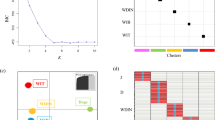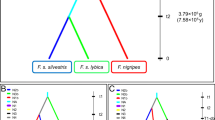Abstract
We describe a primer pair that amplifies a 203 base pair fragment containing 4 single nucleotide polymorphisms (SNPs) within the cytochrome b region of the mitochondrial DNA that, when sequenced, conclusively distinguishes Washington state gray wolves from domestic dogs. The method is more efficient and cost-effective than other established methods for genetically distinguishing domestic dogs from gray wolves when using potentially degraded scat samples. Further testing may find that the SNP panel is also applicable to studies in Oregon, Idaho, Montana, and Wyoming, as these wolves belong to the same distinct population segment as Washington state gray wolves.

Similar content being viewed by others
References
Altschul SF, Gish W, Myers EW, Lipman DJ (1990) Basic local alignment search tool. J Mol Biol 215:403–410
Björnerfeldt S, Webster MT, Vilà C (2006) Relaxation of selective constraint on dog mitochondrial DNA following domestication. Genome Res 16:990–994
Chambers SM, Fain SR, Fazio B, Amaral M (2012) An account of the taxonomy of North American wolves from morphological and genetic analyses. N Am Fauna 77:1–67
Ersmark E, Klütsch CF, Chan YL, Sinding M-HS, Fain SR, Illarionova NA, Oskarsson M, Uhlén M, Zhang Y-p, Dalén L (2016) From the past to the present: wolf phylogeography and demographic history based on the mitochondrial control region. Front Ecol Evol 4:134
Hendricks SA, Schweizer RM, Harrigan RJ, Pollinger JP, Paquet PC, Darimont CT, Adams JR, Waits LP, Hohenlohe PA, Wayne RK (2019) Natural re-colonization and admixture of wolves (Canis lupus) in the US Pacific Northwest: challenges for the protection and management of rare and endangered taxa. Heredity 122:133
Imes DL, Wictum EJ, Allard MW, Sacks BN (2012) Identification of single nucleotide polymorphisms within the mtDNA genome of the domestic dog to discriminate individuals with common HVI haplotypes. For Sci Int-Gen 6:630–639
Kim KS, Lee SE, Jeong HW, Ha JH (1998) The complete nucleotide sequence of the domestic dog (Canis familiaris) mitochondrial genome. Mol Phylogen Evol 10:210–220
Koblmüller S, Vilà C, Lorente-Galdos B, Dabad M, Ramirez O, Marques-Bonet T, Wayne RK, Leonard JA (2016) Whole mitochondrial genomes illuminate ancient intercontinental dispersals of grey wolves (Canis lupus). J Biogeogr 43:1728–1738
Leonard J, Vilá C, Wayne R (2005) Legacy Lost: Genetic variability and population size of extirpated US gray wolves. Mol Ecol 14:198–206
Pang J-F, Kluetsch C, Zou X-J, Zhang A-b, Luo L-Y, Angleby H, Ardalan A, Ekström C, Sköllermo A, Lundeberg J (2009) mtDNA data indicate a single origin for dogs south of Yangtze River, less than 16,300 years ago, from numerous wolves. Mol Biol Evol 26:2849–2864
Parker HG, Kim LV, Sutter NB, Carlson S, Lorentzen TD, Malek TB, Johnson GS, DeFrance HB, Ostrander EA, Kruglyak L (2004) Genetic structure of the purebred domestic dog. Science 304:1160–1164
Smalling BB, Satkoski JA, Tom BK, Szeto WY, Erickson B, Spear T, Smith D, Budowle B, Webb K, Allard M (2010) Geographic differences in mitochondrial DNA (mtDNA) distribution among United States (US) domestic dog populations. Open Foren Sci J 3:22–32
Stansbury CR, Ausband DE, Zager P, Mack CM, Waits LP (2016) Identifying gray wolf packs and dispersers using noninvasive genetic samples. J Wildl Manage 80:1408–1419
Strakova A, Leathlobhair MN, Wang G-D, Yin T-T, Airikkala-Otter I, Allen JL, Allum KM, Bansse-Issa L, Bisson JL, Domracheva AC (2016) Mitochondrial genetic diversity, selection and recombination in a canine transmissible cancer. Elife 5:e14552
Tamura K, Stetcher G, Peterson D, Filipski A, Kumar S (2013) MEGA6: molecular evolutionary genetics analysis (MEGA) version 6.0. Mol Biol Evol 30:2725–2729
Thalmann O, Shapiro B, Cui P, Schuenemann VJ, Sawyer SK, Greenfield D, Germonpré M, Sablin M, López-Giráldez F, Domingo-Roura X (2013) Complete mitochondrial genomes of ancient canids suggest a European origin of domestic dogs. Science 342:871–874
Vilà C, Savolainen P, Maldonado JE, Amorim IR, Rice JE, Honeycutt RL, Crandall KA, Lundeberg J, Wayne RK (1997) Multiple and ancient origins of the domestic dog. Science 276:1687–1689
Vilà C, Amorim IR, Leonard JA, Posada D, Castroviejo J, Petrucci-Fonseca F, Crandall KA, Ellegren H, Wayne RK (1999) Mitochondrial DNA phylogeography and population history of the gray wolf Canis lupus. Mol Ecol 8:2089–2103
Vilà C, Seddon J, Ellegren H (2005) Genes of domestic mammals augmented by backcrossing with wild ancestors. Trends Genet 21:214–218
vonHoldt BM, Pollinger JP, Lohmueller KE et al (2010) Genome-wide SNP and haplotype analyses reveal a rich history of underlying dog domestication. Nature 464:898–903
Vynne C, Baker MR, Breuer ZK, Wasser SK (2012) Factors influencing degradation of DNA and hormones in maned wolf scat. Anim Conserv 15:184–194
Waples RS, Kays R, Fredrickson RJ, Pacifici K, Mills LS (2018) J Hered 109:585–597
Wasser SK, Houston CS, Koehler GM, Cadd GG, Fain SR (1997) Techniques for application of faecal DNA methods to field studies of Ursids. Mol Ecol 6:1091–1097
Wasser SK, Davenport B, Ramage ER, Hunt KE, Parker M, Clarke C, Stenhouse G (2004) Scat detection dogs in wildlife research and management: applications to grizzly and black bears in the Yellowhead Ecosystem, Alberta, Canada. Can J Zool 82:475–492
Wasser SK, Keim JL, Taper ML, Lele SR (2011) The influences of wolf predation, habitat loss and human activity on caribou and moose in the Alberta oil sands. Front Ecol Env 9:546–551
Wayne RK, Lehman N, Allard MW, Honeycutt RL (1992) Mitochondrial DNA variability of the gray wolf: genetic consequences of population decline and habitat fragmentation. Conserv Biol 6:559–569
Webb KM, Allard MW (2009) Mitochondrial genome DNA analysis of the domestic dog: identifying informative SNPs outside of the control region. J Foren Sci 54:275–288
Witt KE, Malhi RS (2014) Ancient domestic dog diversity in the Americas: A mitochondrial DNA analysis of pre-European contact dogs. Am J Phys Anthropol 153:276–276
Witt KE, Judd K, Kitchen A, Grier C, Kohler TA, Ortman SG, Kemp BM, Malhi RS (2015) DNA analysis of ancient dogs of the Americas: identifying possible founding haplotypes and reconstructing population histories. J Hum Evol 79:105–118
Acknowledgements
We thank the Conservation Canine dog teams for their collection of scats used in this study. Positive control tissue samples were provided by the Burke Museum of Natural History and Washington Department of Wildlife. Jennifer White, Yue Shi, Yves Hoareau, Ada Kaliszewska, Tara Wilson, HJ Kim, Will Sano, Laura Prugh, Peter Mahoney, Tristan Nuñez, Taylor Ganz, and Mira Sytsma provided comments on the manuscript. Funding for this work was provided by the Maritz Family Foundation, the Dawkins Charitable Trust and the Arthur L. and Elaine V. Johnson Foundation. This manuscript is dedicated to Tuppence, the childhood dog of Ellen Reese.
Author information
Authors and Affiliations
Corresponding author
Additional information
Publisher's Note
Springer Nature remains neutral with regard to jurisdictional claims in published maps and institutional affiliations.
Electronic supplementary material
Below is the link to the electronic supplementary material.
12686_2020_1130_MOESM1_ESM.pdf
Supplementary file1 The Washington State gray wolf CanidSNP haplotype compared to those of domestic dog, coyote and red fox, with mitochondrial nucleotide positions of the gray wolf SNPs shown in bold and position within the mitochondrial genome shown by base pair number (top). The elk haplotype is included to reference the expected amplicon with this primer pair in cases where canid DNA is not present. Wolf, dog, coyote, and red fox haplotypes were determined from alignments available on GenBank (see Table S1), whereas the elk haplotypes were determined from scat sequences obtained during this study (accession numbers pending) (PDF 423 kb)
Rights and permissions
About this article
Cite this article
Reese, E.M., Winters, M., Booth, R.K. et al. Development of a mitochondrial DNA marker that distinguishes domestic dogs from Washington state gray wolves. Conservation Genet Resour 12, 497–501 (2020). https://doi.org/10.1007/s12686-020-01130-2
Received:
Accepted:
Published:
Issue Date:
DOI: https://doi.org/10.1007/s12686-020-01130-2




